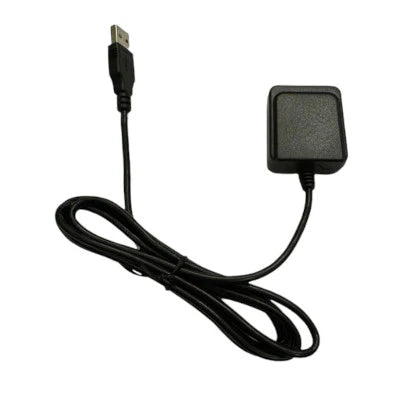Navisys
Navisys GR-M02 Industrial Grade L1 + L5 Dual-Band USB GNSS Receiver (1.5m Accuracy, 10Hz Update Rate, IPX7 Waterproof, Fully EMI Shielded, Operating Temperatures from -40°C to +85°C)
Navisys GR-M02 Industrial Grade L1 + L5 Dual-Band USB GNSS Receiver (1.5m Accuracy, 10Hz Update Rate, IPX7 Waterproof, Fully EMI Shielded, Operating Temperatures from -40°C to +85°C)
Country of Origin: Taiwan
Couldn't load pickup availability
The NaviSys GR-M02 is a high-quality GNSS receiver designed for industrial and commercial use. It is built on Airoha’s (a subsidiary of MediaTek) single-chip dual-band AG3335 engine, featuring 135 channels and supporting both L1 and L5 dual bands.
This dual-band capability allows the GR-M02 to receive signals from both L1 and L5 band satellites, effectively canceling out errors introduced when signals pass through the ionosphere and troposphere. This results in higher accuracy compared to single-band GNSS, with the GR-M02 achieving precision within 1.5 meters.
The 135 channels enable the GR-M02 to utilize more channels for faster satellite acquisition.
The GR-M02 supports smart jammer detection across GPS, GLONASS, Galileo, and BEIDOU bands. This feature enables real-time monitoring and identification of interference signals, ensuring high-precision and reliable positioning data even in challenging environments. It is particularly valuable for applications like drone navigation, vehicle tracking, and security monitoring, where accurate positioning is crucial despite potential interference.
In addition to its excellent GNSS engine, the GR-M02 features a slim smart antenna, making it compact with dimensions of 40 x 45 x 18.5 mm. This small size does not compromise its performance.
This GNSS receiver is IPX7 waterproof, fully EMI shielded, and operates within a wide temperature range from -40°C to +85°C. It also boasts ultra-low power consumption at 94 mA and supports an update rate of up to 10 Hz.
Navisys "NaviViewerAh" Tool
The manufacturer Navisys offers a user-friendly tool for easy configuration and diagnostics of the GR-M02 GNSS receiver. The 2 screenshots below display the satellite signal bars for L1 and L5, respectively.


GM-M02 Module
If you only need the module rather than a complete industrial-grade GNSS receiver, consider the GM-M02, which is the module version of the GR-U01 GNSS receiver.
Receiver Specifications
GNSS receiver type
• 135-channel Airoha AG3335 engine
L1:
• 1602 MHz: GLONASS: L1OF
• 1575.42 MHz:
• GPS & QZSS: L1 C/A
• SBAS: L1
• QZSS L1 SAIF
• Galileo: E1 (E1B+E1C)
• 1561.098 MHz: BEIDOU B1I
L5:
• 1176.45 MHz:
• GPS & QZSS: L5
• Galileo: E5a
• BEIDOU: B2a
Horizontal Position Accuracy
• Autonomous: 1.5m (L1+L5 dual-band)
(CEP, 50%, 24hr static, -130dBm)
Vertical Position Accuracy
• Autonomous: 2.25m (L1+L5 dual-band)
(CEP, 50%, 24hr static, -130dBm)
Velocity Accuracy
• <0.05 m/s (speed)
(50%@30 m/s)
Accuracy of PPS Time Pulse
• ±10 ns clear sky, 1-sigma
Time To First Fix
• Autonomous (50% -130dBm)
• Hot start: 1 sec
• Warm start: 24 sec
• Cold start: 24 sec
Sensitivity
• -148 dBm (acquisition)
• -165 dBm (tracking)
Measurement Data Output
• Max. update rate: 10 Hz (default 1 Hz)
• NMEA output protocol: Ver. 3.01 and 4.10
• UART default baud rate: 115200 bps, (N-8-1)
• Datum: WGS-84
• Default: GGA, GSA, GSV, RMC, VTG
Max. Altitude
• < 50,000 m
Max. Velocity
• < 500 m/s or 1,852 km/hr
SBAS Support
• WAAS, EGNOS, MSAS, GAGAN
• QZSS: SLAS (Sub-meter Level Augmentation) support in Japan Only
Dynamics
• < 4g
Power Consumption
• 94 mA / average tracking (RS232, 77 SVs used in fix)
Power Supply
• 3.3 ~ 5 VDC (TTL, RS232)
• 4.5 ~ 5.5 VDC (USB)
Dimension
• 40 (W) x 45 (L) x 18.5 (H) mm
Operating Temperature
• -40°C to +85°C
Storage Temperature
• -40°C to +85°C
Package Content:
• Navisys GR-M02 GNSS Receiver x 1
Product Resources
Driver Downloads:
(For Windows 10, Windows 11, Android, and Linux, native drivers are already included with the operating system. There’s no need to download or install additional drivers. Simply plug in the GNSS receiver, and it will be recognized and start working immediately.)
-
 Windows Drivers
Windows Drivers
-
 WinCE for x86
WinCE for x86
-
 WinCE for ARM/xScale
WinCE for ARM/xScale
-
 MacOS driver install instructions
MacOS driver install instructions
-
 Linux Driver for Linux Kernel is V2.6.15 0 V5.4
Linux Driver for Linux Kernel is V2.6.15 0 V5.4
-
 USB GNSS driver already built-in to Linux OS 5.5 and above. No need to downloads.
USB GNSS driver already built-in to Linux OS 5.5 and above. No need to downloads.
Tool Downloads:
How to Articles and Blogs:
Tech Support Topics and Forums:








